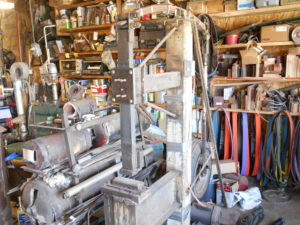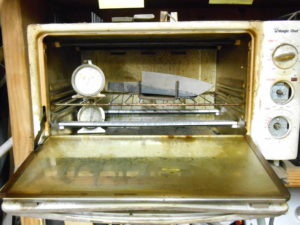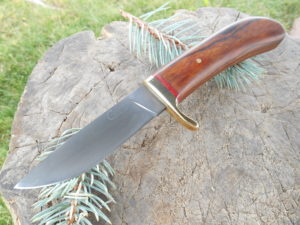
How to keep your shop in operating order and maintain a safe and happy family life in the process
By Joe Calton
There have been tons of stories on how to be a knifemaker. Most are great and deal with subjects like taxes, suppliers, marketing, sales, bookkeeping and safety. Other great articles cover the technical side of how to make the knives you wish to sell, including stories on forging, grinding, heat treating, handles, sheaths and more.
My story will outline some things I have learned over the years as a full-time knifemaker in a home-shop setting that I think will benefit you, your knives and, most importantly, your family.

The GREAT 8
1) Buy a toaster! Your wife’s kitchen oven is not the place to be tempering knives, warming up knife sheaths for waxing them, heating Kydex® for the molding, or burning out axe heads. A $5 toaster at the flea market will do all that in your shop and is a bargain at twice the price.

Buy a toaster! Your wife’s kitchen oven is not the place to be tempering knives, warming up knife sheaths for waxing them, heating Kydex® for the molding or burning out axe heads.
2) Along with the toaster, while at the thrift shop get a selection of pots and pans, cutting boards and a small scale. Trust me, the lure of using one of your wife’s pots or pans for “just this one little project” will be too great—and that is not a road you want to travel! Forget this one and dinner may taste a little “off”—even if you were able to sneak the pan out of the kitchen and into the shop and back again.
3) Install a sink in the shop. At the very least, put a five-gallon bucket of water on a stand for washing your hands before you head into the house. You may not mind grease, oil and dust prints on your clothes, but one time of leaving a smear of quenching oil on your wife’s nice clothes and your knifemaking will take a big hit. Spilling acid on a concrete floor also has far fewer ramifications than spilling it on the countertop in the kitchen. Oh—and don’t forget to wipe your feet on the way into the house.

4) If who like your coffee as much as I do, get a big thermos, fill it in the morning, and take it to the shop with you. This cuts down on the trips away from the shop, as a trip inside the house to grab another cup can turn into an hour away by the time you get the cup, peek in the fridge, check for phone messages, etc.
5) Know when to quit for the day. This is one lesson I’m still learning. You get wrapped up in your work and the next thing you know it’s 2 in the morning. Not only will you spend that night on the couch, but you may spend the next one there too if, as a result, you also forgot the plans you made, dinner, one or more of the kids’ school activities, etc. It’s tough to make good knives after a rough night on the couch.

6) Use some of your knife money to buy your wife flowers. Buy them on a regular basis. Put it on the calendar if you must so you will remember. Think of the flowers as supplies, like grinding belts. This is very important! Not if but when you forget one of the preceding tips, hopefully you will have gotten her flowers recently—and it just may save your bacon. For the home-based knifemaker, buying flowers for the wife is at least as important as safety glasses. You can continue to make knives with only one eye but you cannot make knives if you have been dispatched with a heavy frying pan.


7) Know that what happens in your shop does not stay in your shop, and act accordingly. Dust from exotic woods will make it into your home. You may not be allergic to them but your wife, kids or family pets may be. Keep an eye peeled for anything out of the ordinary when introducing new woods or materials into your shop. This also goes for smoke from quenching. Use “green” quenchants when you can, including vegetable-based oils and water. And keep the door to the rest of the house closed until you clear the air.
8) If you’re considering moving your shop away from your house, think long and hard about it. Yes, a home-based shop offers some challenges. However, it offers quite a few benefits, too. Among them: the morning commute is a thing of the past so you save fuel and time, you have a good place to fix toys and household appliances, and everyone always knows where to find you. If you are a workaholic like me, the home-based shop keeps you at home instead of at the office. Move the shop as some friends of mine have done and you may end up moving it right back.

Also, when you take a break, throw a load of clothes in the washer and they will be ready for the dryer by your next break. Or, you can start a crock-pot meal for that evening’s dinner. By the way, there is no better test of the kitchen knives you make than to use them in making dinner a couple nights a week. This is a twofer in that not only do you get the immediate feedback from hands-on testing, but also the household benefits of cooking a couple meals a week will go far toward keeping your knifemaking in the good graces of “The Boss.”
2 BIGGEST CHALLENGES
My list of tips is not complete. It is based on my experiences in working from a home-based shop, which is a two-car garage attached to the house by a single door. You may be in a detached shop or a basement. Whatever your setup, I hope I have helped with two of the biggest challenges faced by a knifemaker in a home-based shop: keeping the shop in operating order and maintaining a happy home life in the process.
For more information e-mail Joe Calton at joe@caltoncutlery.com.
Install a sink in the shop. You may not mind grease, oil and dust prints on your clothes, but one time of leaving a smear of quenching oil on your wife’s nice clothes and your knifemaking will take a big hit. The sheath knife with blade hamon and wood handle and brass rivets is by the author.
 NEXT STEP: Download Your Free KNIFE GUIDE Issue of BLADE Magazine
NEXT STEP: Download Your Free KNIFE GUIDE Issue of BLADE Magazine
BLADE’s annual Knife Guide Issue features the newest knives and sharpeners, plus knife and axe reviews, knife sheaths, kit knives and a Knife Industry Directory.Get your FREE digital PDF instant download of the annual Knife Guide. No, really! We will email it to you right now when you subscribe to the BLADE email newsletter.






